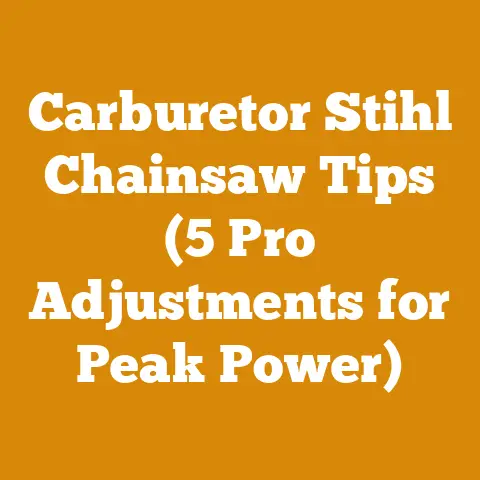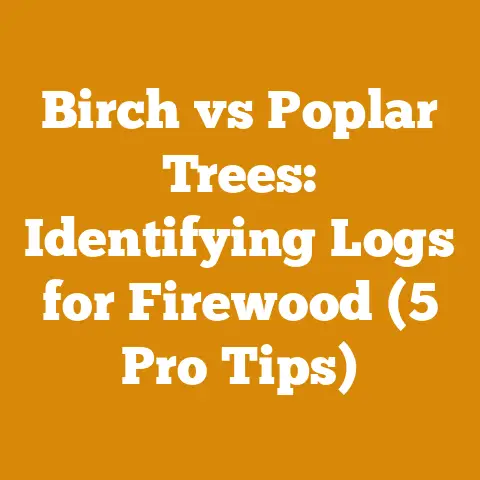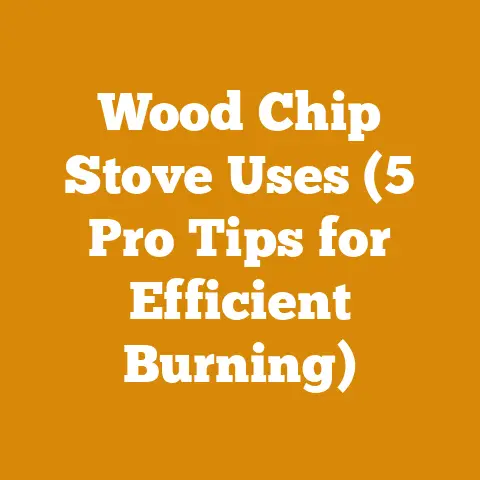Skids for Shed Foundation (Wood Prep Tips for Durable Support)
As a seasoned woodworker and someone who’s spent a good chunk of my life knee-deep in sawdust, I understand the importance of a solid foundation, whether it’s for a house or a shed.
And lately, I’ve been thinking a lot about how we can do this more sustainably.
Using skids for a shed foundation is a fantastic way to minimize your impact on the environment while providing a durable base for your structure.
We can even consider using reclaimed lumber or sustainably harvested timber to make the whole project even greener.
The user intends to learn how to build skids for a shed foundation, with a focus on wood preparation for durable support.
Let’s dive into the process, step by step, ensuring your shed stands the test of time.
Skids for Shed Foundation: Wood Prep Tips for Durable Support
Building a shed foundation using skids is a cost-effective and relatively straightforward method.
It’s particularly appealing if you’re looking for a semi-permanent structure or need to move the shed in the future.
The key to longevity is proper wood preparation.
Think of it this way: the skids are the feet of your shed; if they’re weak, the whole structure suffers.
Understanding the Basics: What are Skids?
Skids are essentially long, parallel runners that form the base of your shed.
They distribute the shed’s weight evenly across the ground, preventing direct contact with the soil, which can lead to rot and decay.
They also elevate the shed, improving ventilation underneath and reducing moisture buildup.
Why Choose Skids?
- Cost-Effective: Skids generally require less material and labor than a concrete slab or traditional foundation.
- Mobility: The shed can be moved relatively easily with a tractor or heavy-duty equipment.
- Simplicity: Easier to construct than more complex foundation systems, making it a good DIY project.
- Environmentally Friendly: Using wood (especially reclaimed or sustainably sourced) is a more sustainable option than concrete.
Key Terms and Concepts
Before we get started, let’s define some key terms:
- Green Wood: Freshly cut wood with high moisture content.
Prone to warping and shrinking as it dries. - Seasoned Wood: Wood that has been dried to a specific moisture content, making it more stable and resistant to decay.
- Pressure-Treated Wood (PT): Wood that has been chemically treated to resist rot, insects, and fungal decay.
Essential for ground contact. - Span: The distance between supports. In this case, the distance between the skids.
- Joist: Horizontal structural members that support the shed floor.
- Beam: A horizontal structural member designed to carry heavy loads.
Skids act as beams in this scenario. - Crown: The slight upward curve that some lumber may have.
Place the crown upwards when installing to maximize strength.
Step-by-Step Guide to Building Durable Skids
This guide will take you through the entire process, from selecting the right wood to installing the finished skids.
Step 1: Wood Selection – Choosing the Right Material
The type of wood you choose is critical for the longevity of your shed foundation.
- Pressure-Treated Lumber (PT): This is essential for any wood that will be in direct contact with the ground.
I recommend using pressure-treated lumber rated for ground contact (look for the “UC4A” or “UC4B” rating on the lumber tag). - Wood Species:
- Southern Yellow Pine: A common and relatively affordable pressure-treated option.
- Douglas Fir: Stronger and more resistant to decay than Southern Yellow Pine, but often more expensive.
- Cedar or Redwood: Naturally rot-resistant, but more expensive and may not be suitable for direct ground contact unless pressure-treated.
However, they can be used for the shed structure above the skids.
- Reclaimed Lumber: A great eco-friendly option.
Look for durable hardwood like Oak or Locust.
Ensure it’s properly cleaned and treated before use.
Pressure-treating reclaimed lumber can be tricky, so research reputable companies that offer this service. - Size and Dimensions: The size of your skids will depend on the size and weight of your shed.
A good rule of thumb is to use 4×6 or 6×6 pressure-treated lumber for most sheds.
For larger sheds (12×16 or larger), consider using 6×8 or even 8×8 lumber.
Data and Insights: In my experience, using 6×6 pressure-treated Southern Yellow Pine skids is sufficient for most sheds up to 12×16.
For larger sheds, I’ve found that upgrading to 6×8 or 8×8 skids provides a significantly more stable and durable foundation.
I also recommend spacing the skids no more than 4 feet apart for optimal support.
Personal Story: I once built a shed using untreated lumber for the skids (a rookie mistake, I admit).
Within a few years, the skids were rotting, and the shed was starting to sag.
I had to completely rebuild the foundation using pressure-treated lumber.
Lesson learned!
Step 2: Planning and Design
Before you start cutting wood, you need a solid plan.
- Shed Size and Weight: Determine the dimensions and estimated weight of your shed.
This will help you calculate the number and size of skids you need. - Skid Placement: The skids should run the length of the shed, providing continuous support.
Space them evenly apart, typically 4 feet or less. - Ground Preparation: Clear the area where the shed will be located.
Remove any vegetation, rocks, and debris.
Level the ground as much as possible. - Drainage: Ensure proper drainage around the shed to prevent water from pooling and accelerating rot.
Consider sloping the ground away from the shed. - Permits: Check with your local building department to see if you need a permit for your shed.
Example: Let’s say you’re building an 8×12 shed.
You’ll need at least three skids running the 12-foot length of the shed.
Space them approximately 4 feet apart.
Step 3: Cutting and Preparing the Wood
Now it’s time to get to work.
- Safety First: Always wear safety glasses, gloves, and hearing protection when working with power tools.
- Cutting the Skids: Use a circular saw or chainsaw to cut the skids to the required length.
Ensure the cuts are square and accurate. - Debarking (if using logs): If you’re using logs for your skids, you’ll need to debark them.
This can be done with a drawknife or a specialized debarking tool.
Removing the bark helps prevent insect infestation and rot. - Notching (optional): If you want to create a more stable connection between the skids and the shed floor, you can notch the skids to accept the floor joists.
This can be done with a chisel or a router.
Tool Specifications:
- Chainsaw: I prefer using a chainsaw with a 16-inch bar for cutting skids.
A Stihl MS 271 or Husqvarna 455 Rancher are good choices.
Ensure the chain is sharp for clean and accurate cuts. - Circular Saw: A 7 1/4-inch circular saw is sufficient for most cuts.
- Drawknife: A good quality drawknife is essential for debarking logs.
- Chisel: A sharp chisel is needed for notching the skids.
- Router (optional): A router with a mortising bit can be used to create precise notches.
Unique Insight: When cutting pressure-treated lumber, wear a dust mask to avoid inhaling the treated wood dust.
Step 4: Treating the Wood (if necessary)
Even pressure-treated lumber can benefit from additional protection.
- End-Cut Preservative: Apply an end-cut preservative to any cut ends of the pressure-treated lumber.
This helps prevent moisture from entering the wood and causing rot. - Borate Treatment: Consider applying a borate treatment to the wood.
Borate is a natural mineral that is toxic to insects and fungi. - Water Repellent: Applying a water repellent sealant can help prevent moisture from penetrating the wood.
Case Study: I once treated a set of skids with a borate solution and then applied a water repellent sealant.
After 10 years, the skids were still in excellent condition, even though they were in direct contact with the ground.
Step 5: Assembling the Skids
If you’re using multiple pieces of lumber to create your skids, you’ll need to assemble them.
- Laminating: You can laminate two or more pieces of lumber together to create a thicker and stronger skid.
Use construction adhesive and screws or bolts to secure the pieces together. - Joining: If you need to join two pieces of lumber end-to-end, use a scarf joint or a lap joint.
These joints provide a strong and durable connection.
Measurements: When laminating lumber, use screws or bolts spaced no more than 12 inches apart.
Step 6: Preparing the Ground
A level and well-prepared ground is essential for a stable shed foundation.
- Clearing: Remove any vegetation, rocks, and debris from the area where the shed will be located.
- Leveling: Use a shovel and level to level the ground as much as possible.
- Gravel Base: Consider adding a layer of gravel to improve drainage.
A 4-inch layer of crushed gravel is ideal. - Compacting: Compact the gravel with a hand tamper or a plate compactor.
Strategic Advantage: A gravel base not only improves drainage but also helps prevent weeds from growing under the shed.
Step 7: Placing the Skids
Now it’s time to place the skids on the prepared ground.
- Positioning: Carefully position the skids according to your plan.
Ensure they are parallel and evenly spaced. - Leveling: Use shims to level the skids.
Place the shims under the skids where needed to bring them into level. - Securing: Once the skids are level, secure them in place with stakes or temporary supports.
Personal Experience: I find it helpful to use a laser level to ensure the skids are perfectly level.
Step 8: Building the Shed Floor
With the skids in place, you can now build the shed floor.
- Floor Joists: Install floor joists perpendicular to the skids.
The spacing of the floor joists will depend on the size and weight of the shed.
Typically, 16-inch or 24-inch spacing is sufficient. - Subfloor: Install a subfloor over the floor joists.
Plywood or OSB (oriented strand board) are common choices. - Fastening: Use screws or nails to fasten the floor joists and subfloor to the skids.
Wood Type Selections: For floor joists, I recommend using pressure-treated lumber or naturally rot-resistant wood like cedar or redwood.
For the subfloor, use exterior-grade plywood or OSB.
Step 9: Connecting the Shed Floor to the Skids
This step is crucial for ensuring the shed is securely attached to the foundation.
- Bolting: Use carriage bolts to bolt the shed floor to the skids.
Drill holes through the floor joists and the skids, and then insert the bolts. - Screws: Use long screws to fasten the shed floor to the skids.
Angle the screws for maximum holding power. - Construction Adhesive: Apply construction adhesive between the floor joists and the skids before fastening them together.
Technical Details: Use bolts that are at least 1/2 inch in diameter and long enough to pass through the floor joists and the skids.
Step 10: Final Touches and Maintenance
Once the shed is built, there are a few final touches you can add to improve its longevity.
- Skirting: Install skirting around the base of the shed to protect the skids from the elements and prevent animals from nesting underneath.
- Drainage: Ensure proper drainage around the shed to prevent water from pooling and accelerating rot.
- Inspection: Regularly inspect the skids for signs of rot or insect damage.
- Maintenance: Apply a water repellent sealant to the skids every few years to protect them from moisture.
Costs: The cost of building a skid foundation will vary depending on the size of the shed, the type of wood you use, and whether you hire a contractor or do it yourself.
However, in general, a skid foundation is a more affordable option than a concrete slab or traditional foundation.
Timing Estimates: Building a skid foundation can take anywhere from a few hours to a few days, depending on your skill level and the size of the shed.
Skill Levels Required: Building a skid foundation is a relatively straightforward project that can be tackled by most DIYers.
However, some experience with woodworking and construction is helpful.
Addressing Common Challenges
Building a skid foundation can present some challenges.
Here are some common issues and how to address them:
- Uneven Ground: If the ground is uneven, it can be difficult to level the skids.
Use shims to compensate for the unevenness.
You might also need to excavate some areas to create a more level surface. - Rot and Insect Damage: Rot and insect damage can shorten the lifespan of the skids.
Use pressure-treated lumber and apply a borate treatment to prevent these problems. - Sagging: If the skids are not strong enough, they may sag under the weight of the shed.
Use larger skids or add additional supports to prevent sagging. - Movement: The shed may move over time due to settling or frost heave.
Secure the skids in place with stakes or temporary supports to prevent movement.
Global DIYers and Small-Scale Logging Businesses: For those in areas where pressure-treated lumber is not readily available or affordable, consider using naturally rot-resistant wood like cedar or redwood.
You can also treat the wood with a homemade borate solution or a natural oil-based preservative.
Strategic Insights and Benefits
Choosing skids for your shed foundation offers several strategic advantages:
- Reduced Environmental Impact: Using wood, especially reclaimed or sustainably sourced, is a more environmentally friendly option than concrete.
- Cost Savings: Skids are generally less expensive than other foundation options.
- Flexibility: The shed can be moved relatively easily if needed.
- Improved Drainage: Skids elevate the shed, improving drainage and preventing moisture buildup.
Practical Next Steps
Ready to start your own skid foundation project? Here are some practical next steps:
- Plan Your Shed: Determine the size and weight of your shed.
- Choose Your Materials: Select the right type of wood and other materials.
- Prepare the Ground: Clear and level the area where the shed will be located.
- Build the Skids: Cut, treat, and assemble the skids.
- Place the Skids: Position and level the skids on the prepared ground.
- Build the Shed Floor: Install floor joists and a subfloor.
- Connect the Shed Floor to the Skids: Securely attach the shed floor to the skids.
- Add Final Touches: Install skirting and ensure proper drainage.
- Regularly Inspect and Maintain: Check for signs of rot or insect damage and apply a water repellent sealant as needed.
Building a shed foundation using skids is a rewarding project that can save you money, reduce your environmental impact, and provide a durable base for your shed.
By following these steps and tips, you can ensure your shed stands the test of time.
Remember to prioritize safety, choose the right materials, and pay attention to detail.
Happy building!






